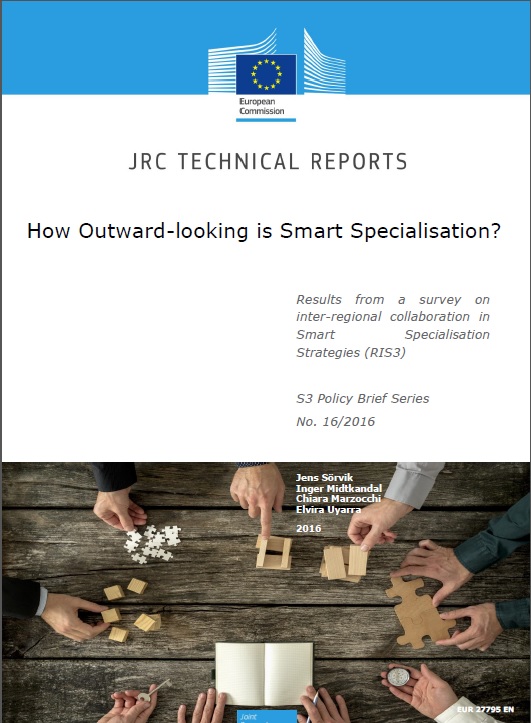How Outward-looking is Smart Specialisation? - Results from a survey on inter-regional collaboration in Smart Specialisation Strategies (RIS3)
Abstract
The report is also available as Power Point.
Smart specialisation (S3) emphasises the identification of niches, cross-sectorial innovation and solving societal challenges. With this comes a need for an outward-looking dimension, to find a region’s potential advantages in international markets, and to identify partners to help deliver new solutions and solve common challenges. This is the case not only for industry and academia, but also for regional policy-makers who need to engage in inter-regional collaboration processes.
The purpose of the survey presented in this report was to increase our understanding of the factors underlying successful inter-regional cooperation within S3. It builds on an analytical framework to better understand the multiple dimensions of inter-regional collaboration, developed in a previous working paper (Uyarra et al., 2014). The objectives of this study were to increase our knowledge of inter-regional collaboration in research and innovation (R&I), with the aim of supporting regions and Member States in their collaborative efforts in S3, but also to inform the S3 Platform (S3P) and other European Commission (EC) services on how to best support inter-regional collaboration in R&I policy.
The answers from the survey respondents indicate that the EU’s new cohesion policy has led some regions and Member States to change their behaviour in collaboration in R&I policy. More than half of the respondents reported having prior collaboration experiences, of which 67 % reported increased collaboration in the previous 2 years and 30 % reported a stable level of collaborative effort. The factors driving collaboration and the perceived benefits of collaboration include information sharing, meeting a new orientation of regional policy and supporting linkages between R&I and industry. Collaboration largely involves low-intensity activities that bring direct and immediate benefits. Collaboration is most prominent in the first steps of the RIS3 process, analysis, design and decision-making.
The criteria underlying the choice of partners are in line with the RIS3 concept; they are based on industry composition (similar or complementary), research capabilities that are complementary or similar, as well as similar societal challenges. In contrast, the survey findings regarding the geographical location of partnering regions could negate the RIS3 concept, as regions most often collaborate with other regions in their own country.
The main barriers to collaboration seem to be inter-related and include lack of resources, insufficient political commitment, insufficient engagement of regional stakeholders and lack of clarity of objectives. One interpretation is that it is challenging to communicate clearly to stakeholders and politicians the outcomes of an intervention, with the result that stakeholders are unwilling commit or mobilise resources. The rationale for innovation policy interventions quite often is to support activities that provide indirect and dynamic benefits that are not easily measured, divisible or attributable to individual actors or activities. In contrast, the least problematic barriers are socio-cultural issues, legal or administrative barriers and lack of trust.
It is recommended that regions and Member States better prepare the evidence base for their projects and improve the materials they use to communicate to stakeholders the potential benefits of collaboration and how to achieve them. Regions should also engage more with private sector actors and civil society.
The paper indicates the importance of the EC communicating a more complex picture of the dynamics of inter-regional collaboration. An oversimplification of the message might lead to underinvestment and less intensive collaboration than that which is needed to address the larger challenges with potential for longer-term benefits for Europe.
The recommendations for S3P include that it should focus on learning activities and support the initiation of collaborative processes. However, it appears that the regions and Member States want S3P support to implement thematic collaboration, but then to be left to themselves to carry it out. Likewise, respondents considered it important that S3P should provide guidance, act as a knowledge hub and offer expert assistance. This indicates that S3P should continue to develop knowledge around inter-regional collaboration and assist regions and Member States in establishing and developing this.
Series
S3 Policy Brief Series No. 16/2016
